Domestic anxiety: Tomaso De Luca‘s property traps
An unexpected intervention into a unique Venetian house creates a world of domestic anxiety & dangerous traps. Extrapolating from a 2019 story in which a property developer was nearly struck by an improvised knife contraption, Tomaso De Luca has created a space instilling the home with fear - physical, political, and economic.
When in 2019 a team of Philadephia real estate agents encountered a Home Alone
style booby-trap, which would have seen a knive come swinging towards them as they climbed a staircase, it led artist Tomaso De Luca to think about more than the violent event that could have taken place, and into the deeper violences of gentrification, power, and economics.
![]()
![]()
![]()
figs.i-iii
For his installation at this year’s Venice Biennale, De Luca has turned a uniquely designed domestic space into an uncanny, nervous space of risk and fear. The space De Luca’s work was located was already a somewhat unexpected and anxiety-inducing space. Completely fitted out in tiles by Dutch designers Droog, the lowly-lit space seemed more of an interrogation chamber, cell, sex sauna, or abatoir, than a domestic environment. In fact, it was the ground floor of Casa Venezia, residence of art collectors Massimo Adario and Dimitri Borri, and then kitted out minimalistically for guests and events, but upon entry from the sunlit narrow street it took on a more haunting atmosphere.
Upon entering, the first space is filled with a projected film featuring models and maquettes of tiny torture equipment. A piece of furniture with nails protruding. An anvil. A guillotene positioned near a mouse-hole in the skirting board. A door ajar with a plank and weight on the floor, as if it had fallen when somebody entered. Deeper into the room, a display case collected the physical models together, as if evidence in a criminal proceedings.
![]()
![]()
![]()
figs.iv-vi
In a nearby space, a sculptural contraption comprising open sockets, glass bottle, and nail board appeared as an improvised adult-sized mousetrap. There seemed a number of ways that the sculpture could be triggered to disastrous end - if any exhibition needed a “don’t touch the art” sign, this was it. That the space was formed of wipe-clean tiles only added to the architectural anxiety.
![]()
![]()
Outside, on the courtyard staircase leading higher into the home, a single crutch stood precariously with two knives pointing directly towards anybody who wanted to climb the steps. There is a comedic angle to this, also picked up by that model of an anvil referencing Looney Tunes’ various cartoon traps, but the artist is also touching on the genuine fear and anxiety of dispossession, foreclosure, gentrification, and loss of the home evident in the USA and across nations of late-capitalism.
![]()
![]()
figs.x-xi
The installation, part of the fringe events at the Biennale, was organised by Lofoten International Art Festival - held on a cluster of islands on the northern coast of Norway just above the Arctic Circle - and the upcoming edition’s curatorial team of Francesco Urbano Ragazzi. It was presented in Venice for only the opening week of Biennale, alongside Pauline Curnier Jardin’s permanent installation within the Casa di Reclusione Femminile della Giudecca women’s prison, where the artist collaborated with inmates to create a wall-based work filling a room which is the transitional space between prison and outside world

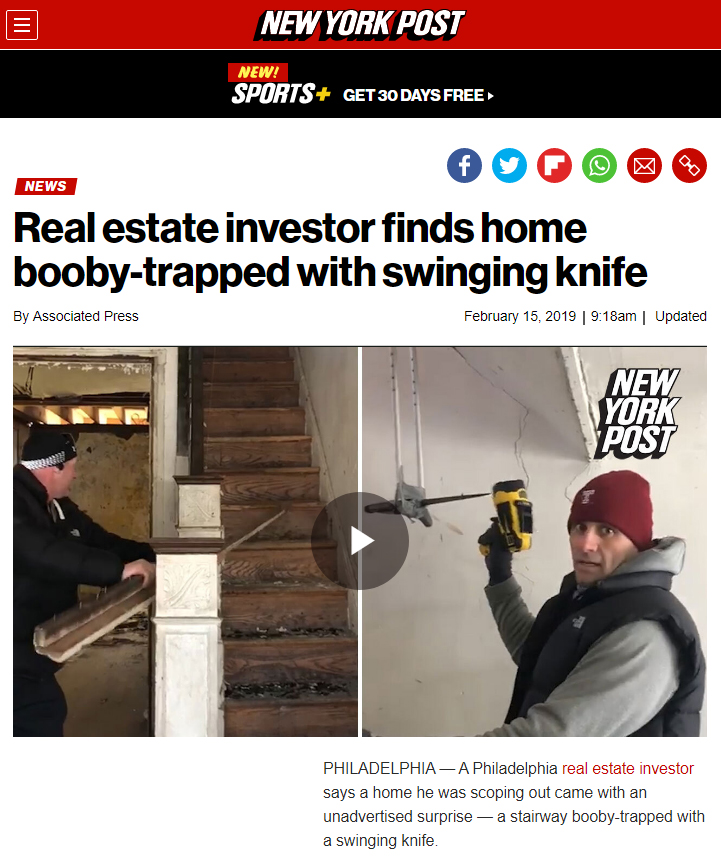

figs.i-iii
For his installation at this year’s Venice Biennale, De Luca has turned a uniquely designed domestic space into an uncanny, nervous space of risk and fear. The space De Luca’s work was located was already a somewhat unexpected and anxiety-inducing space. Completely fitted out in tiles by Dutch designers Droog, the lowly-lit space seemed more of an interrogation chamber, cell, sex sauna, or abatoir, than a domestic environment. In fact, it was the ground floor of Casa Venezia, residence of art collectors Massimo Adario and Dimitri Borri, and then kitted out minimalistically for guests and events, but upon entry from the sunlit narrow street it took on a more haunting atmosphere.
Upon entering, the first space is filled with a projected film featuring models and maquettes of tiny torture equipment. A piece of furniture with nails protruding. An anvil. A guillotene positioned near a mouse-hole in the skirting board. A door ajar with a plank and weight on the floor, as if it had fallen when somebody entered. Deeper into the room, a display case collected the physical models together, as if evidence in a criminal proceedings.
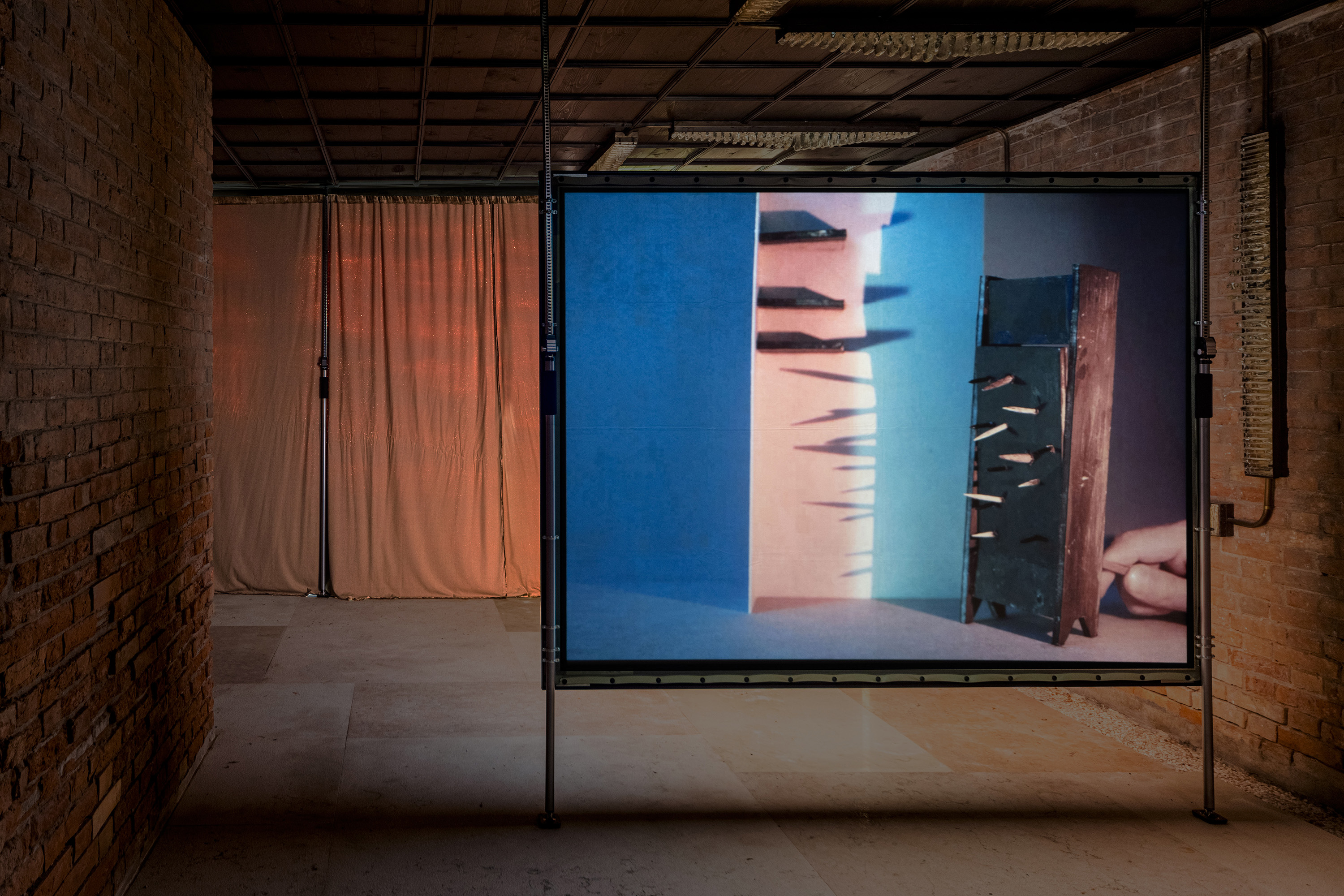
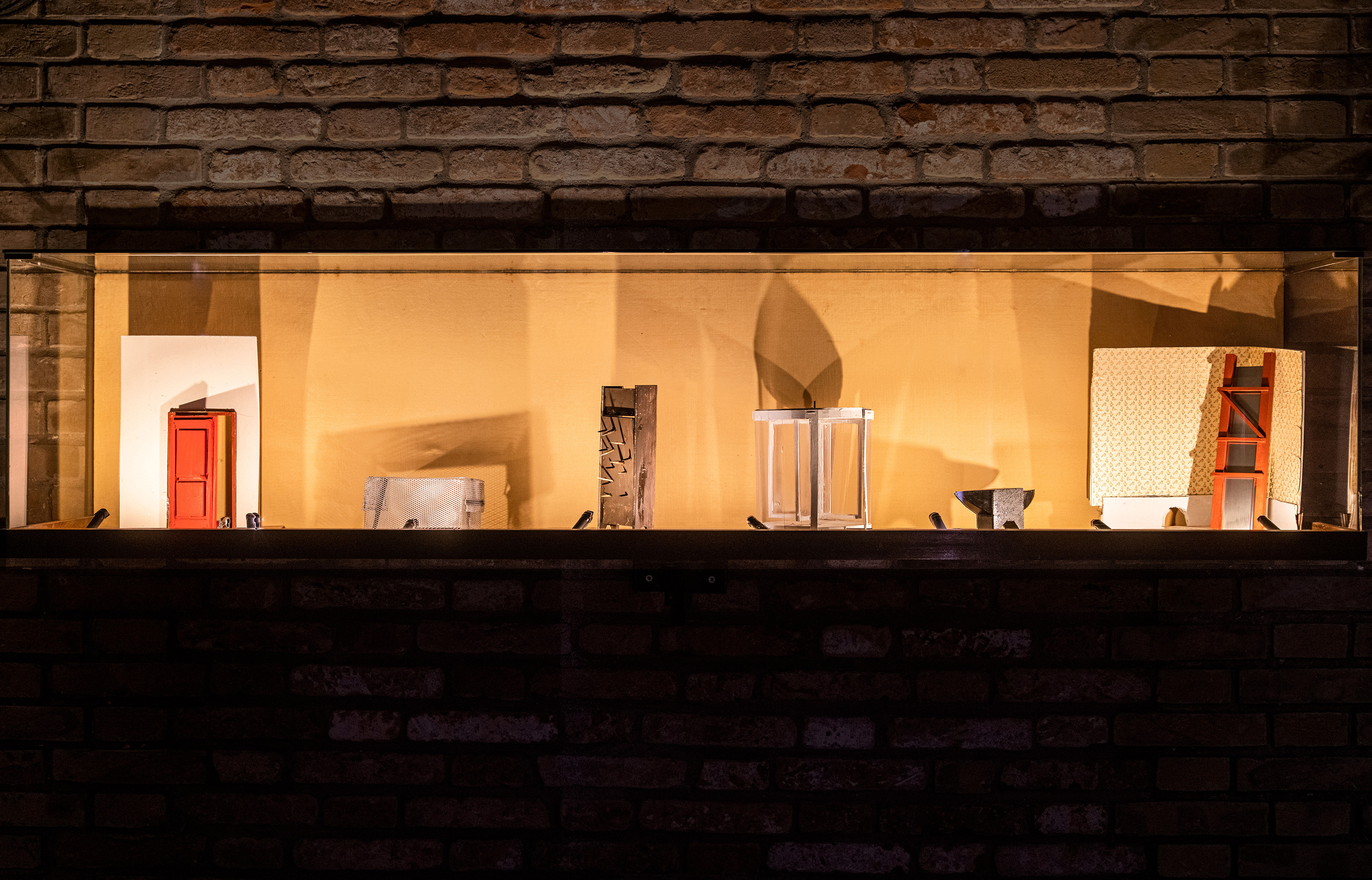
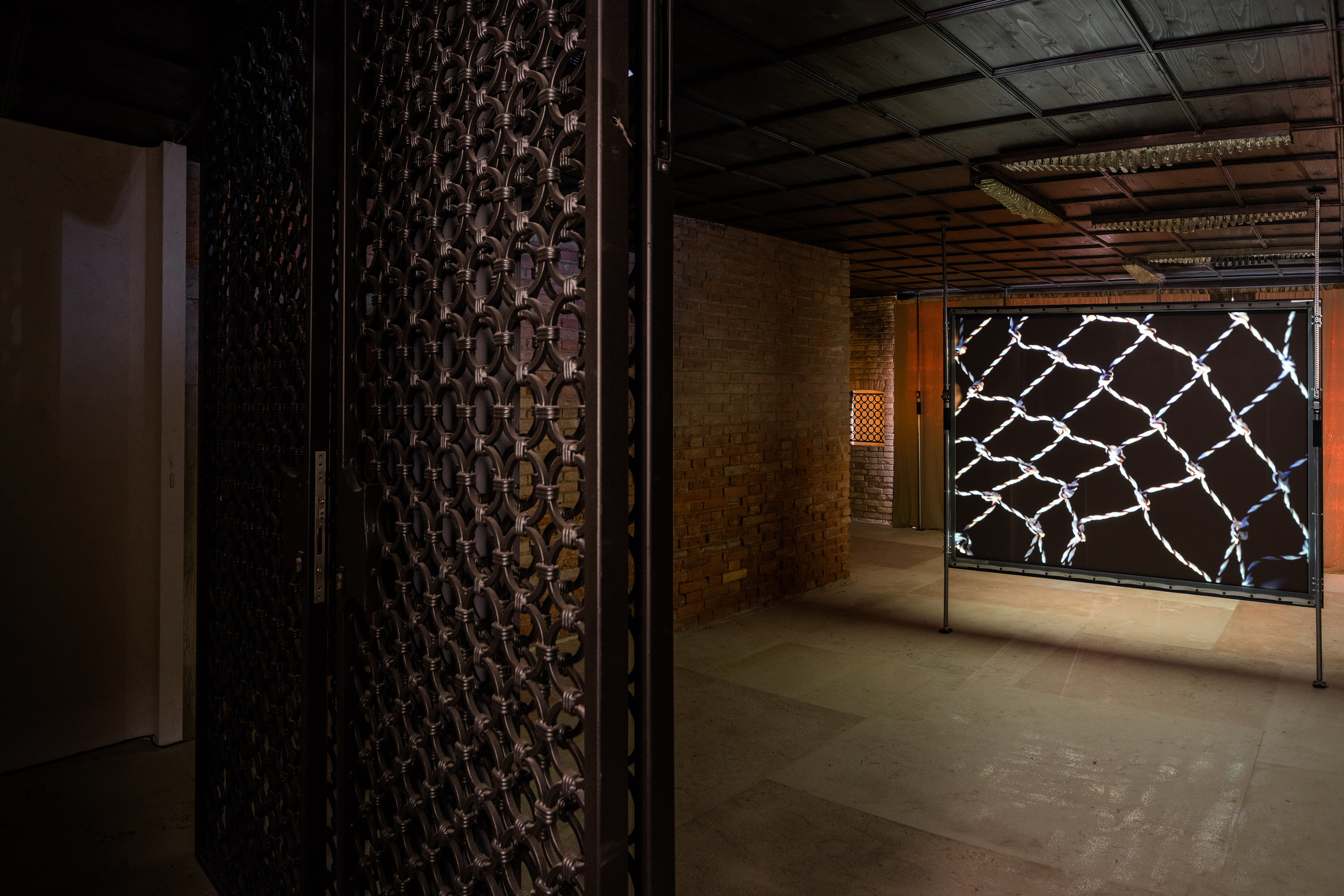
figs.iv-vi
A projector flicked through ambiguous images, throwing unsettling frames onto a domestic boiler - body parts, machinary, ghostly forms - they were hard to make them out with clarity, but also an unnerving sense it was probably better not to.
In a nearby space, a sculptural contraption comprising open sockets, glass bottle, and nail board appeared as an improvised adult-sized mousetrap. There seemed a number of ways that the sculpture could be triggered to disastrous end - if any exhibition needed a “don’t touch the art” sign, this was it. That the space was formed of wipe-clean tiles only added to the architectural anxiety.
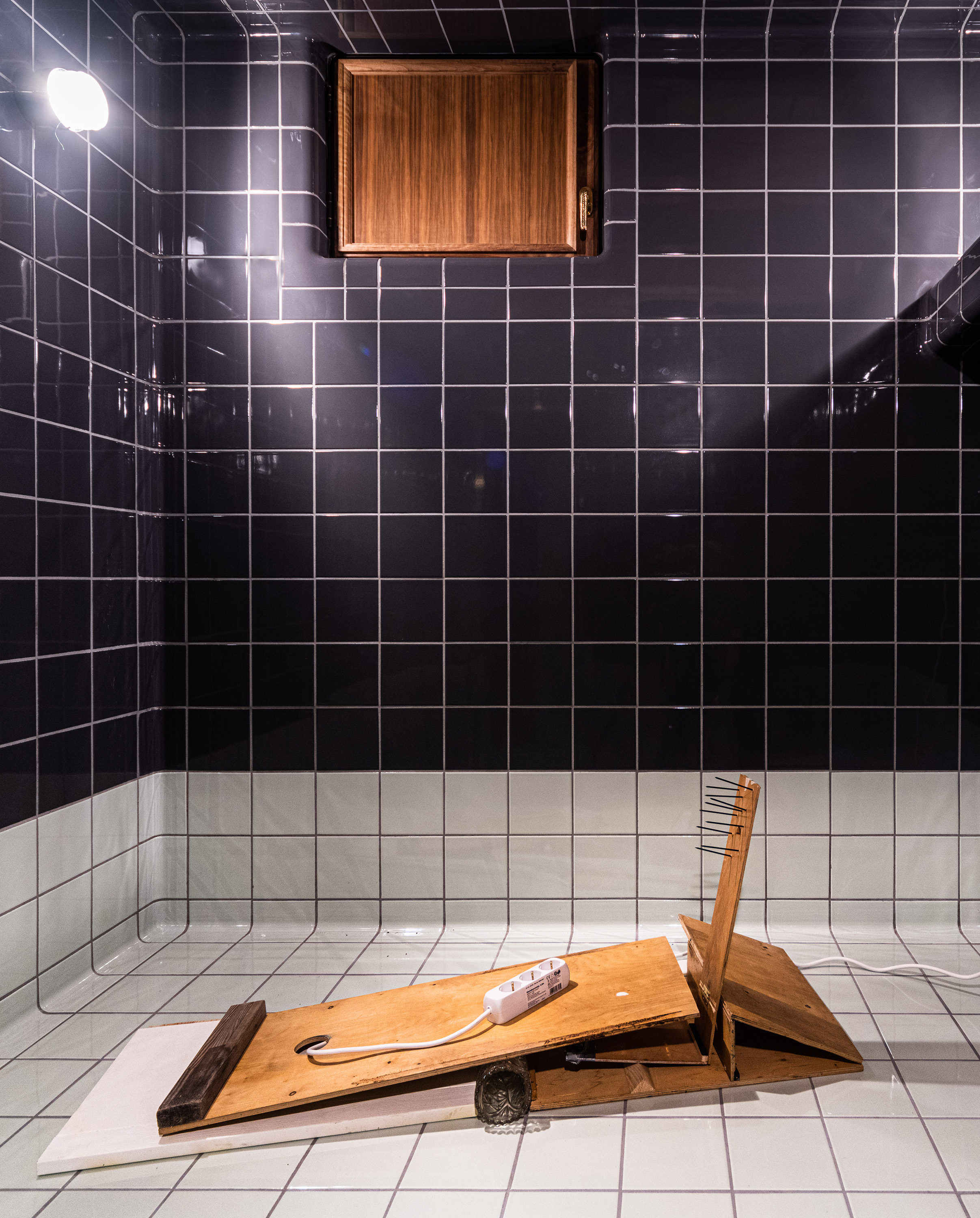

figs.vii-ix
Outside, on the courtyard staircase leading higher into the home, a single crutch stood precariously with two knives pointing directly towards anybody who wanted to climb the steps. There is a comedic angle to this, also picked up by that model of an anvil referencing Looney Tunes’ various cartoon traps, but the artist is also touching on the genuine fear and anxiety of dispossession, foreclosure, gentrification, and loss of the home evident in the USA and across nations of late-capitalism.
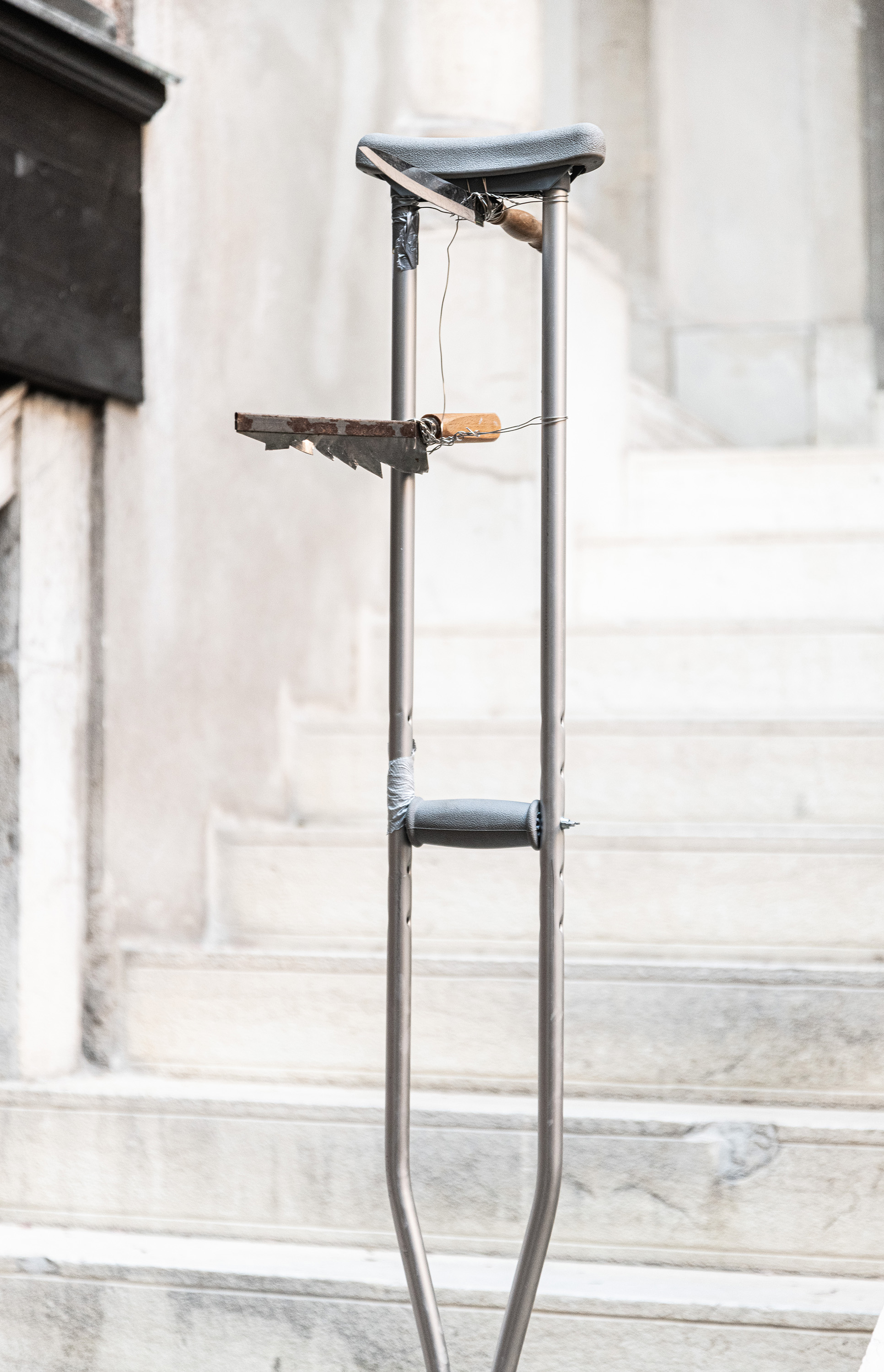
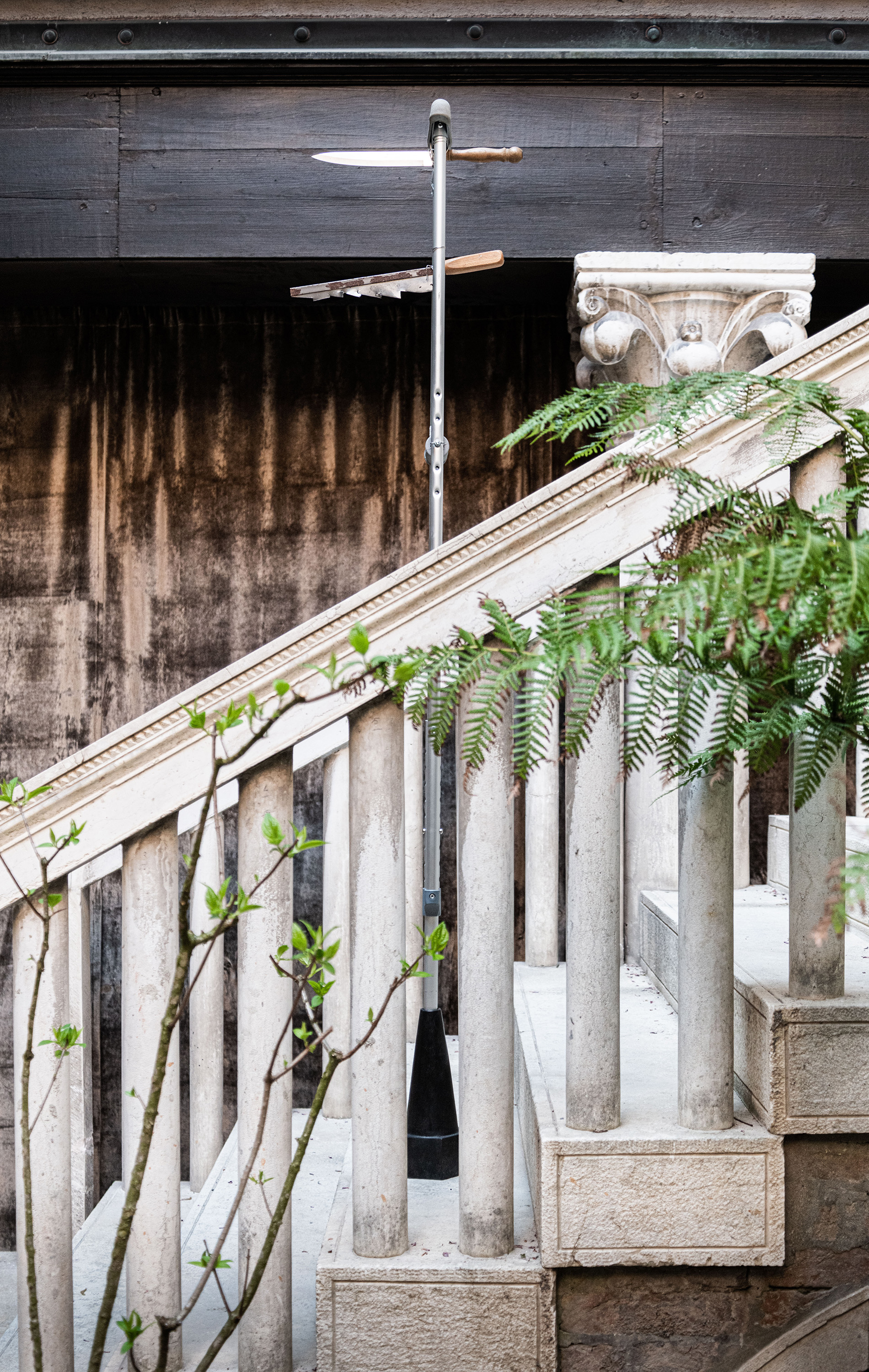
figs.x-xi
The installation, part of the fringe events at the Biennale, was organised by Lofoten International Art Festival - held on a cluster of islands on the northern coast of Norway just above the Arctic Circle - and the upcoming edition’s curatorial team of Francesco Urbano Ragazzi. It was presented in Venice for only the opening week of Biennale, alongside Pauline Curnier Jardin’s permanent installation within the Casa di Reclusione Femminile della Giudecca women’s prison, where the artist collaborated with inmates to create a wall-based work filling a room which is the transitional space between prison and outside world
Tomaso De Luca (1988) is a visual artist who lives and works in Berlin. He employs drawing, sculpture,
installation, and video practices to expose what is buried in collective imagery: his works stand as defectionsto the modernist canon, representing active survival strategies against isolation. De Luca’s work has been
exhibited in venues such as: Quadriennale di Roma (2020); Contemporary Art Centre, Vilnius (2017); Parque
Lage, Rio de Janeiro (2015); Fondazione Sandretto Re Rebaudengo, Turin (2015); among others. He was
among the finalists of the 9th Furla Prize in 2013, and was awarded the title of Cy Twombly Fellow at the
American Academy in Rome, in 2017. In 2021, his work A Week’s Notice won the second edition of the MAXXI
Bvlgari Prize.
www.tomasodeluca.com
Lofoten International Art Festival [LIAF] is a biennial festival for contemporary art - the longest running event of its kind in Scandinavia - taking
place in Lofoten, a cluster of islands located on the Northern Coast of Norway, just above the Arctic Circle.
Since 1999, LIAF has presented works by international artists in a local and site-specific context. LIAF acknowledges the complexity of place and seeks to be a discursive, engaged and social platform for
different positions creating dialogue between the local and global. Since 2009, the festival has been run by
the North Norwegian Art Center (NNKS) and LIAF’s Artistic Advisory Board. LIAF and NNKS receive operational
support from the Arts Council Norway, the counties of Finnmark, Troms and Nordland, and the municipality of
Vågan. About the Lofoten Islands Lofoten is an archipelago and a traditional district in the county of
Nordland, Norway. Though lying within the Arctic Circle, the archipelago experiences one of the world’s
largest elevated temperature anomalies relative to its high latitude. Lofoten is known for its distinctive scenery with mountains and peaks, open sea and sheltered bays, beaches and untouched lands.
www.info.liaf.no
Francesco Urbano Ragazzi is an Italian curatorial duo founded in Paris in 2008. The team developed TheInternet Saga, a research platform and cycle of exhibitions that started with a homonymous solo show by
Jonas Mekas (2015), and culminated with the exhibition Hillary: The Hillary Clinton Emails by Kenneth Goldsmith
(2019), both presented in unconventional contexts on the occasion of the Venice Biennale. Francesco Urbano
Ragazzi has also curated projects and exhibitions for MMCA (Seoul), Iscp (New York), Centro Ricerca Castello
di Rivoli (Turin), Centre d’Art Contemporain (Gèneve), La Loge (Brussels), La Casa Encendida (Madrid), Institut Français (Paris), Futura (Prague), Ruya Foundation (Baghdad), Emirates Foundation (Abu Dhabi), among
others. Since 2017, the team is directing the archive of feminist artist Chiara Fumai; in this capacity they
curated the first monograph of her work. In 2021 the duo co-edited FUORI 1971-1974, an anthology dedicated
to the first gay liberation movement in Italy.
www.ffur.eu
www.info.liaf.no
Francesco Urbano Ragazzi is an Italian curatorial duo founded in Paris in 2008. The team developed TheInternet Saga, a research platform and cycle of exhibitions that started with a homonymous solo show by
Jonas Mekas (2015), and culminated with the exhibition Hillary: The Hillary Clinton Emails by Kenneth Goldsmith
(2019), both presented in unconventional contexts on the occasion of the Venice Biennale. Francesco Urbano
Ragazzi has also curated projects and exhibitions for MMCA (Seoul), Iscp (New York), Centro Ricerca Castello
di Rivoli (Turin), Centre d’Art Contemporain (Gèneve), La Loge (Brussels), La Casa Encendida (Madrid), Institut Français (Paris), Futura (Prague), Ruya Foundation (Baghdad), Emirates Foundation (Abu Dhabi), among
others. Since 2017, the team is directing the archive of feminist artist Chiara Fumai; in this capacity they
curated the first monograph of her work. In 2021 the duo co-edited FUORI 1971-1974, an anthology dedicated
to the first gay liberation movement in Italy.
www.ffur.eu
images
figs.i-iii various news reports from 2019.
figs.iv-v
Desperate
Times, 2022. Video, colour, sound,
loop, 16’35”. View of the exhibition at Casa Venezia, Venice, IT. Courtesy: the artist, LIAF, Case Chiuse by Paola Clerico and Monitor,
Rome, Lisbon, Pereto.
Photograph
© Claudia Rossini.
fig.vi
Desperate
Times (models), 2022. Mmixed media,
variable dimension. View of the exhibition at Casa Venezia, Venice, IT. Courtesy: the artist, LIAF, Case Chiuse by Paola
Clerico and Monitor, Rome, Lisbon, Pereto.
Photograph © Claudia Rossini.
fig.vii
Trödel (thirst
traps), 2022. Photographic
print on silver paper 30 x 42 cm (framed). Courtesy: the artist, LIAF, Case Chiuse by Paola
Clerico and Monitor, Rome, Lisbon, Pereto.
Photograph © Claudia Rossini.
fig.viii
Trödel (thirst
traps), 2022. Side projection,
digital print on film, 40 slides. Courtesy: the artist, LIAF, Case Chiuse by Paola
Clerico and Monitor, Rome, Lisbon, Pereto.
Photograph © Claudia Rossini.
fig.ix
Charger, 2022. Wood, iron, glass,
brass, duct tape, varnish, extension board, 110 x 47 x 55 cm. Courtesy: the artist, LIAF, Case Chiuse by Paola
Clerico and Monitor, Rome, Lisbon, Pereto.
Photograph © Claudia Rossini.
figs.x-xi
Angora, 2022. Bronze, cement, resin,
aluminum, rubber, plastic, iron, wood, stainless steel, 190 x 25 x 35 cm. Courtesy: the artist, LIAF, Case Chiuse by Paola
Clerico and Monitor, Rome, Lisbon, Pereto.
Photograph © Claudia Rossini.
images
fig.i Lorem ipsum dolor sit amet, consectetur adipiscing elit. Vivamus pulvinar risus quis feugiat commodo. Suspendisse rhoncus diam et viverra dignissim. Integer ac quam sed lectus eleifend volutpat.
fig.ii Sed consequat ante eget magna rhoncus ultricies laoreet sit amet odio. © Lorem Ipsum
publication date
27 April 2022
tags
Cartoon, Pauline Curnier Jardin, Droog, Installation, Tomaso De Luca, Francesco Urbano Ragazzi, Gentrification, LIAF, Lofoten International Art Festival, Politics, Property, Sculpture, Trap, Venice Biennale, Video, Violence
figs.iv-v Desperate Times, 2022. Video, colour, sound, loop, 16’35”. View of the exhibition at Casa Venezia, Venice, IT. Courtesy: the artist, LIAF, Case Chiuse by Paola Clerico and Monitor, Rome, Lisbon, Pereto. Photograph © Claudia Rossini.
fig.vi Desperate Times (models), 2022. Mmixed media, variable dimension. View of the exhibition at Casa Venezia, Venice, IT. Courtesy: the artist, LIAF, Case Chiuse by Paola Clerico and Monitor, Rome, Lisbon, Pereto. Photograph © Claudia Rossini.
fig.vii Trödel (thirst traps), 2022. Photographic print on silver paper 30 x 42 cm (framed). Courtesy: the artist, LIAF, Case Chiuse by Paola Clerico and Monitor, Rome, Lisbon, Pereto. Photograph © Claudia Rossini.
fig.viii Trödel (thirst traps), 2022. Side projection, digital print on film, 40 slides. Courtesy: the artist, LIAF, Case Chiuse by Paola Clerico and Monitor, Rome, Lisbon, Pereto. Photograph © Claudia Rossini.
fig.ix Charger, 2022. Wood, iron, glass, brass, duct tape, varnish, extension board, 110 x 47 x 55 cm. Courtesy: the artist, LIAF, Case Chiuse by Paola Clerico and Monitor, Rome, Lisbon, Pereto. Photograph © Claudia Rossini.
figs.x-xi Angora, 2022. Bronze, cement, resin, aluminum, rubber, plastic, iron, wood, stainless steel, 190 x 25 x 35 cm. Courtesy: the artist, LIAF, Case Chiuse by Paola Clerico and Monitor, Rome, Lisbon, Pereto. Photograph © Claudia Rossini.


